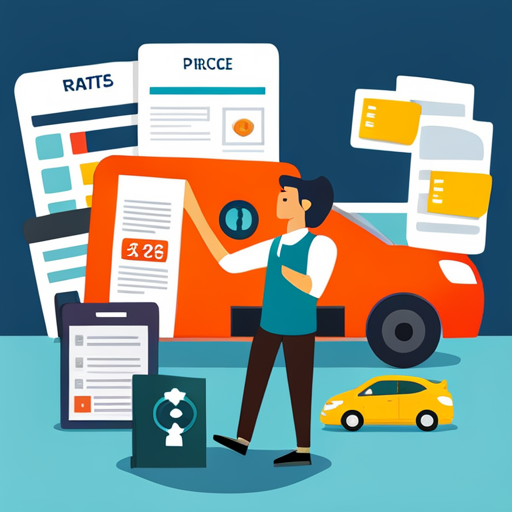"Cherishing Little Steps - A Haven for Baby and Family Journeys"
Teenager Car Buying Tips
Are you a teenager dreaming of owning your first car? Well, you’re not alone! Many teens wonder if buying a car is even possible at their age. But guess what? It’s time to debunk that myth and show you that with the right knowledge and guidance, buying a car as a teenager can be within your reach.
In this guide, we’ll provide you with valuable tips and advice on how to navigate the car buying process. From setting a budget to researching different car models, exploring financing options to understanding maintenance costs, we’ve got you covered.
So, let’s dive in and empower you to make an informed decision when it comes to purchasing your first car.
Setting a Budget

When setting a budget for buying a car as a teenager, start by carefully assessing your financial situation. This step is crucial in ensuring that you make a wise decision and avoid any unnecessary financial strain. To begin, consider your income and expenses. Determine how much money you have available to allocate towards car-related expenses, such as monthly payments, insurance, fuel, and maintenance.
Next, it’s important to implement saving strategies. Saving money before purchasing a car can help you avoid taking on excessive debt. Consider setting aside a portion of your income each month specifically for your car fund. Additionally, explore ways to cut back on unnecessary expenses and redirect those savings towards your car budget. This might involve making small sacrifices in your daily spending habits or finding creative ways to generate extra income.
As a teenager, there are also several factors to consider when setting your car budget. Think about the type of car you need, taking into account factors such as fuel efficiency, reliability, and safety ratings. Consider the cost of insurance for different car models, as this can vary significantly. It’s also important to factor in the potential costs of maintenance and repairs.
Researching Different Car Models

To make an informed decision, regularly research different car models that fit your needs and budget. Comparing features and reading customer reviews are essential steps in finding the right car for you. By doing your homework, you can ensure that you are making a wise investment and getting the best value for your money.
To help you get started, here is a table comparing three popular car models in terms of their key features and customer reviews:
| Car Model | Features | Customer Reviews |
|---|---|---|
| Model A | – Fuel efficient | – Excellent performance |
| – Advanced safety | – Comfortable interior | |
| features | – Satisfied customers | |
| ————- | ————————- | ———————— |
| Model B | – Spacious interior | – Reliable performance |
| – User-friendly | – Smooth ride | |
| infotainment system | – Positive feedback | |
| ————- | ————————- | ———————— |
| Model C | – Sporty design | – Great fuel economy |
| – Strong engine | – High customer ratings | |
| performance | – Overall satisfaction |
By comparing features and reading customer reviews, you can gather valuable insights about each car model. Consider your specific needs and preferences, such as fuel efficiency, safety features, interior space, and performance, to make an informed decision. Additionally, customer reviews provide firsthand experiences from others who have owned or driven the car, giving you a better understanding of its reliability and overall satisfaction.
Exploring Financing Options

Once you have researched different car models, it’s time to explore financing options to determine how you’ll afford your desired vehicle. Financing a car is a big decision, and it’s important to consider all available loan options and understand how your credit score will impact your choices. Here are three key points to keep in mind:
-
Loan Options: When it comes to financing a car, you have several options to consider. One option is to get a loan from a bank or credit union. Another option is to finance through the dealership, where they arrange the loan on your behalf. Additionally, you may want to explore the possibility of getting a cosigner, such as a parent or guardian, to help you secure a loan with better terms.
-
Credit Score: Your credit score plays a crucial role in determining the interest rate and terms of your loan. A good credit score can help you secure a lower interest rate, which means you’ll end up paying less over the life of the loan. It’s important to check your credit score before applying for a loan and take steps to improve it if necessary.
-
Budgeting: Before committing to a car loan, it’s essential to assess your budget and determine how much you can comfortably afford to pay each month. Consider factors such as insurance, maintenance, and fuel costs in addition to the monthly loan payment. It’s crucial to choose a loan option that fits within your budget to avoid financial strain in the long run.
Considering Used Vs. New Cars

If you’re a teenager looking to buy a car, it’s important to consider whether you should purchase a used or new vehicle. There are pros and cons to both options, and several factors to consider before making your decision.
One of the main advantages of buying a used car is the lower cost. Used cars are generally more affordable than new ones, making it easier to fit within your budget. Additionally, used cars have already undergone their initial depreciation, so you won’t experience the same rapid decrease in value as with a new car.
On the other hand, new cars come with their own set of benefits. First and foremost, new cars typically come with a warranty, providing you with peace of mind in case of any unforeseen issues. New cars also offer the latest technology and safety features, which can enhance your driving experience and keep you safer on the road.
When deciding between a used or new car, consider factors such as your budget, your desired features, and your long-term goals. Think about how long you plan to keep the car and whether you’re willing to take on the additional costs associated with a new vehicle, such as higher insurance rates.
Ultimately, the choice between a used or new car depends on your personal preferences and circumstances. Take the time to weigh the pros and cons before making your decision, and consider seeking advice from a trusted adult or car expert to ensure you make the right choice for your needs.
Checking Car Insurance Rates

Check your insurance rates before purchasing a car. It’s important to understand the cost of insurance as it can significantly impact your overall budget. Here are three reasons why comparing coverage options and finding affordable rates is crucial:
-
Financial Responsibility: As a teenager, it’s crucial to be financially responsible. By comparing coverage options, you can find a policy that suits your needs and budget. This helps ensure that you can afford the premiums and coverage without compromising your financial stability.
-
Cost Savings: Insurance rates can vary significantly depending on the car you choose. By comparing rates from different insurance providers, you can find the most affordable option that still offers adequate coverage. This can lead to significant cost savings in the long run.
-
Peace of Mind: Having the right insurance coverage gives you peace of mind while on the road. Accidents happen, and knowing that you’re protected financially can help alleviate stress. By finding affordable rates, you can enjoy your driving experience without worrying about high insurance costs.
To find the best insurance rates, consider reaching out to multiple insurance providers and obtaining quotes. It’s also beneficial to consider factors such as your driving record and any available discounts. Remember, finding the right insurance coverage at an affordable rate is essential for your financial well-being.
Test Driving Potential Vehicles

Before making a purchase, ensure you test drive potential vehicles to assess their performance and suitability. Test driving is an essential step in the car buying process as it allows you to experience firsthand how the vehicle handles, accelerates, and brakes. It also gives you the opportunity to check for any potential issues or discomforts that may arise during your daily commute.
When visiting a car dealership, it’s important to follow proper car dealership etiquette. Be polite and respectful to the salesperson assisting you, as they’re there to help you find the right vehicle. Ask questions about the vehicle’s features, maintenance history, and any additional warranties or services that may be offered. Remember to negotiate the terms of the test drive, such as the duration and the route you’ll take, to ensure that you have ample time to assess the vehicle’s performance.
During the test drive, pay attention to the vehicle’s acceleration, braking, and steering response. Test it on different types of roads to get a comprehensive feel for how it handles in various conditions. Take note of any strange noises, vibrations, or smells that may indicate potential mechanical issues. Evaluate the comfort and ergonomics of the seats, the visibility from the driver’s seat, and the ease of use of the vehicle’s controls.
Finally, when returning from the test drive, express your gratitude to the salesperson for their time and assistance, regardless of whether you decide to purchase the vehicle. This shows your appreciation for their help and maintains a positive relationship.
Getting a Vehicle History Report

To ensure you have all the necessary information about a potential vehicle, it’s important to obtain a vehicle history report. This report provides valuable insights into the car’s past, helping you make an informed decision.
Here are three reasons why getting a vehicle history report is crucial:
-
Understanding accident history: A vehicle history report reveals if the car has been involved in any accidents in the past. This information is vital because it allows you to assess the extent of damage and potential repairs needed. By knowing the accident history, you can gauge the overall condition of the vehicle and determine if it’s worth considering.
-
Checking for odometer fraud: Odometer fraud is a common issue in the used car market. Dishonest sellers may tamper with the odometer to make the vehicle appear less driven than it actually is. A vehicle history report can help you verify the mileage by providing records of previous odometer readings. This ensures that you’re not paying for a car that has significantly more wear and tear than indicated.
-
Peace of mind: By obtaining a vehicle history report, you can gain peace of mind knowing that you have thoroughly researched the car’s background. It minimizes the risk of purchasing a vehicle with hidden problems, potential safety issues, or undisclosed information.
Negotiating the Price

Once you have reviewed the vehicle history report, it’s time to negotiate the price of the car. Negotiating the price can be a daunting task, especially for a teenager buying their first car. However, with effective strategies and winning negotiation techniques, you can secure a fair deal. Here are some tips to help you negotiate the price successfully:
| Effective Strategies | Winning Negotiation Techniques |
|---|---|
| Do your research | Be confident and respectful |
| Set a budget | Start with a lower offer |
| Point out flaws | Use silence as a negotiation tool |
| Be prepared to walk away | Offer to pay in cash |
| Consider timing | Ask for extras or discounts |
Understanding Maintenance and Repair Costs

Understanding the cost of maintenance and repairs is crucial for teenagers when buying a car. As a teenager, you want to make sure you choose a vehicle that won’t break the bank when it comes to keeping it in good shape. Here are some key points to consider when understanding maintenance and repair costs:
-
Understanding warranty coverage: Before purchasing a car, it’s important to understand what warranty coverage it comes with. Warranties can vary in terms of duration and coverage, so make sure you know what repairs are covered and for how long. This will help you budget for any potential repairs that may not be covered by the warranty.
-
Finding reliable mechanics: Building a relationship with a reliable mechanic is essential for keeping your car running smoothly. Look for mechanics who specialize in your car’s make and model, as they’ll have the expertise needed to diagnose and fix any issues. Ask for recommendations from friends, family, or online communities to find trusted mechanics in your area.
-
Regular maintenance and preventative care: By keeping up with regular maintenance, such as oil changes, tire rotations, and fluid checks, you can prevent costly repairs down the line. Following the manufacturer’s recommended maintenance schedule will help you identify and address any potential issues before they become major problems.
Making a Final Decision and Purchase

When considering making a final decision and purchase for your car, prioritize researching reliable dealerships. This step is crucial to ensure that you’re getting a fair deal and that the car you choose is in good condition.
Start by comparing prices and options from different dealerships. Look for dealerships that have a good reputation and positive customer reviews. This will give you an idea of the kind of service and quality you can expect from them.
Once you have narrowed down your options, visit the dealerships in person to inspect the cars and take them for a test drive. During this process, pay attention to the condition of the car, its mileage, and any potential issues that may need to be addressed.
Once you have found the car that meets your needs and budget, it’s time to finalize the deal. Negotiate the price and terms with the dealer, and don’t be afraid to walk away if you’re not satisfied. Remember, it’s important to be confident and assertive when making your final decision and purchase.
Frequently Asked Questions
How Can I Save Money on Car Insurance as a Teenager?
To save money on car insurance as a teenager, you can follow these tips: maintain a clean driving record, take a defensive driving course, choose a safe and reliable vehicle, and consider adding a responsible adult as a co-driver.
What Are Some Common Mistakes to Avoid When Negotiating the Price of a Car?
When negotiating the price of a car, it’s important to avoid common mistakes. Focus on negotiation strategies and effective communication. By doing so, you can ensure a successful outcome and get the best deal possible.
How Do I Know if a Used Car Has Been in an Accident?
To know if a used car has been in an accident, check its history using services like Carfax. Look for signs like mismatched paint, uneven panel gaps, or a bent frame. Don’t hesitate to bring in a trusted mechanic for a thorough inspection.
Are There Any Additional Costs to Consider When Buying a New Car?
When buying a new car, it’s important to consider additional costs like extended warranties and hidden fees. These can add up and impact your budget. Take the time to research and negotiate to ensure you’re getting the best deal.
What Should I Do if I Change My Mind After Purchasing a Car?
If you change your mind after purchasing a car, you may have the option to cancel the purchase and return the car. However, it’s important to check the dealership’s return policy and be prepared for any potential fees or restrictions.
Conclusion
In conclusion, buying a car as a teenager can be a daunting task, but with the right research and preparation, it can also be an exciting and rewarding experience.
Remember that the average cost of car insurance for teenagers is a staggering $3,900 per year. This statistic highlights the importance of considering all factors, such as insurance rates, maintenance costs, and financing options, before making a final decision.
By being informed and making smart choices, you can find the perfect car that fits both your needs and budget.


